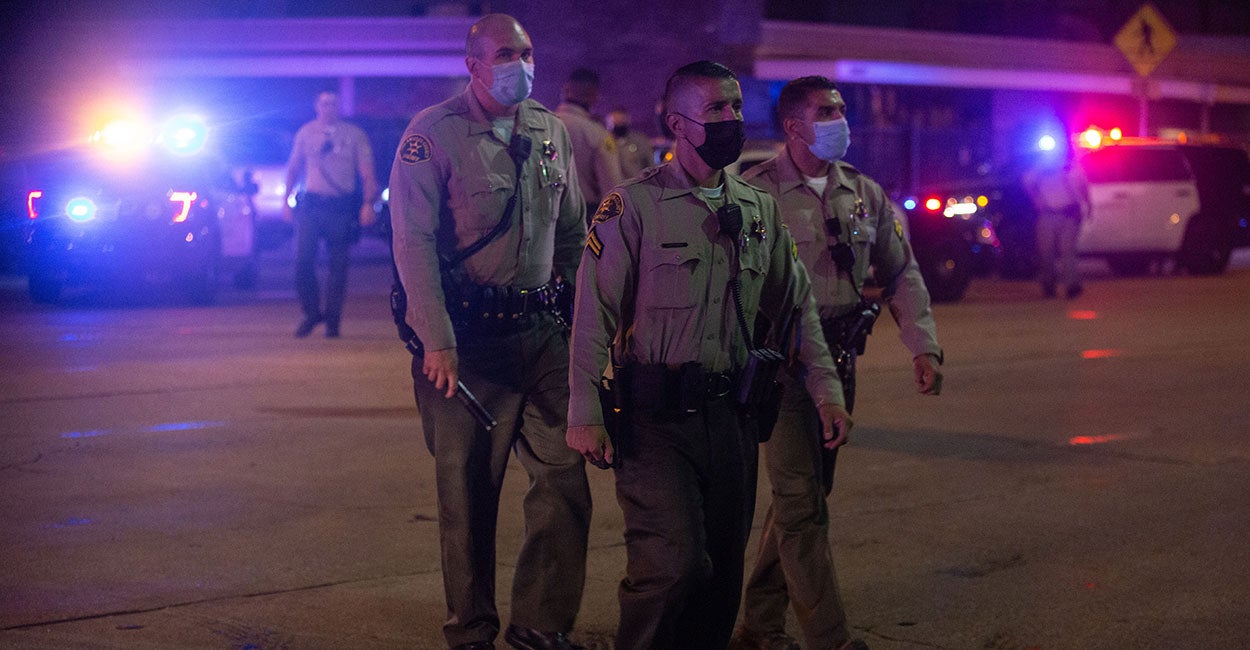Jon Kyle, a retired deputy sheriff from the San Bernardino County Sheriff’s Department in California, has a lawman’s perspective on what happened Aug. 23 when a white police officer shot Jacob Blake, a 29-year-old African American man, in Kenosha, Wisconsin. Kyle joins the podcast to discuss how he views the incident in which police officers confronted Blake.
We also cover these stories:
The Daily Signal depends on the support of readers like you. Donate now
- An organization run by a co-founder of Black Lives Matter asks for donations to a group with ties to communist China.
- Insurance companies are going to be out at least $1 billion after paying for damage claims resulting from riots following the May 25 death of George Floyd at the hands of police.
- The director of the Centers for Disease Control and Prevention, Dr. Robert Redfield, tells a Senate committee that masks are crucial in the fight against COVID-19.
“The Daily Signal Podcast” is available on Ricochet, Apple Podcasts, Pippa, Google Play, and Stitcher. All of our podcasts can be found at DailySignal.com/podcasts. If you like what you hear, please leave a review. You can also leave us a message at 202-608-6205 or write us at letters@dailysignal.com. Enjoy the show!
Rachel del Guidice: I’m joined today on “The Daily Signal Podcast” by Jon Kyle. He’s a retired deputy sheriff. Jon, thank you for being with us on “The Daily Signal Podcast.”
Jon Kyle: It’s my pleasure.
Del Guidice: Well, thanks for making the time to talk with us.
As someone retired in law enforcement, I want to talk a little bit about the situation of Jacob Blake. People know him as the 29-year-old African American man who was shot by police on Aug. 23 and a lot of riots ensued after this shooting.
Jon, can you start off by telling us, as a law enforcement officer, your perspective of what happened?
Kyle: Well, in law enforcement, everything you’re trying to do is about reducing your risks. You’re supposed to protect the public first, then yourself.
And when someone is refusing to show you their hands or trying to get into a vehicle after you’ve had an altercation, you have to assume that they’re getting into that vehicle because they’re either going to try and flee or they’re trying to get something out of the vehicle to hurt you—a gun, a knife, whatever implement happens to be there. Could be a tire iron. Even if there’s no other weapon in the car, the car itself is a weapon.
So when Jacob Blake ran to the car, he basically put himself in a situation where the officers had a legitimate reason to believe that he was a lethal threat to them.
I don’t think either of those officers really wanted to be [in] an altercation that day. And I’m absolutely positive neither of them wanted to shoot anybody, especially in the current climate that we’re in. But when he went into that car, he basically put them in a situation where they really didn’t have a whole lot of options.
Del Guidice: Well, as you mentioned, … you were not part of the group of law enforcement that went in. We’re just talking about your perspective as someone who was in law enforcement, who spent years serving.
What do we know about what happened leading up to the shooting? You mentioned the situation with the car, but can you kind of walk us through before shots were fired, everything that transpired?
Kyle: Well, from a variety of different news sources, it’s pretty clear. The original report was that he was a good Samaritan that was just trying to help break up a fight between two people and that has been proven to be completely untrue.
There was a warrant out for his arrest for sexual assault and the woman that lives at the residence where they were trying to arrest him was the victim of that assault.
When he came back, she called the police and said, “I want you to come help.” So she told the police she needed help. She invited them to come into the situation.
When they went to arrest Mr. Blake, he physically assaulted the officers, physically fought with them. They both tried to tase him—first one and then the other. That was unsuccessful. He tried to put one of the officers in a headlock.
Nobody’s seen the whole incident, the[y] only see that little snippet of it. But those fights, even if it’s only for a minute or two, can seem like they’re hours. If you’re in a fight where somebody is trying to hurt me, it seems like they never end.
When he started running toward the car, I understand that his kids were in the car, so they couldn’t shoot at him from the front of the vehicle.
If I were in that situation and I had the option, I wouldn’t have run around behind him and grabbed his shirt the way the officer did, but they really didn’t have a lot of options because if they’d stood to the front of the vehicle and shot toward him, they would have had to worry about hitting the children in the car.
So the fact that he was shot in the back had a lot to do with the fact that the officers didn’t want to shoot the kids in the car, probably. That’s how I see it happening. I see them trying to avoid shooting toward innocents.
Del Guidice: A point you had made before we talked is that the narrative that some are talking about is how the officers were wrong even shooting in the first place. Can you talk a little bit about … why you take issue with this narrative and what your perspective is?
Kyle: The main thing that I originally brought to you is that it’s become common to say, “Well, the officers and the police officers need more training.”
The assumption that’s built into that statement is that the officers didn’t know what the rules were, that when they shot it was inappropriate. In this particular case, it was completely a justified shooting.
Cops get a lot more training than most people think they are. And most of the people that are commenting on the training that they get have no idea what they go through.
When I graduated from the academy 29 years ago, they were already teaching community involvement and sensitivity to different cultures, how to deescalate.
There was a guy that had a training program, and I have no idea what the department paid for that training program, but the department that I was a part of literally sent every deputy in the department to see this guy. And at that time it was about $1,200.
So police agencies invest a great deal of money in training officers how to manage situations, how to deescalate. And so when they start talking about how officers need more training, I wonder how much they know about the training the officers received in the first place. My guess is very little.
Del Guidice: On that note, Jon, … I know we’ve heard a lot of [conversations] and probably even some of us have been a part of those conversations where people do say, “Oh, better training needed for situations like this.” How do you think conservatives should respond?
Kyle: I think that the first question we have to ask is what do we know about the training that’s already being given? If you’re going to comment on something, I generally try and make sure it’s something I know about. And I think most conservatives do that.
But it’s become a real easy thing to just say, “Oh, yeah, well, cops need better training.” And that may be true, but that’s a separate discussion from whether or not the shooting on Jacob Blake was a legitimate shooting or not.
Most cops are always seeking out more training. The department that I was a part of, we went for eight hours of training three times a year. And it wasn’t just shooting. It was different methods of deescalating, law changes. My department and most departments are always trying to make sure that we know what the best way to handle a given situation is.
Unfortunately, there’s as many different situations that cops run into as there are people that they run into. And so it’s very difficult to cover every single base. You have to come up with some guidelines for how to handle them.
In this particular case, though, … there wasn’t really a lot of good arguments for this not being legitimate. I mean, he was a violent felon with a warrant out for his arrest. He was attempting to revictimize the woman that the warrant was out for his arrest over. And so it doesn’t make a lot of sense to say, “Well, the cops just need more training.” That’s basically saying it’s the cops’ fault this happened. It isn’t.
The reality is that every law enforcement encounter, it’s always the suspect or the subject, whichever term you prefer, but it’s always the person that the cop is interacting with that makes the decision about what kind of violence is going to be involved in that encounter. It’s never the cop.
If it is the cop, and the cop is probably using excessive force, if he’s the initiator of the force, then he’s going to probably lose his job and he could go to jail.
So Jacob Blake decided how he was going to respond to the officer. He made choices that ultimately resulted in him being shot. But officers don’t get to make those choices.
Del Guidice: Something that you had talked about before our conversation was how it’s important to remember that in every legitimate law enforcement encounter, it’s always the subject that determines the nature of the encounter and the level of violence. And so how would you explain this perspective in light of the Jacob Blake situation?
Kyle:They went there and I’m sure that they started out with words. They’re your first and your best tool, “Mr. Blake, we have a warrant for your arrest.” At that point he decided to either run or fight.
I haven’t read the report, obviously. It hasn’t been published. So I don’t know how he initiated the incident, but he decided how he was going to respond. He decided to … try and run from the officers or struggle when they tried to put handcuffs on him.
When I went through training, and I don’t imagine this has changed a lot, we were told that we were allowed to use the minimum amount of force necessary to affect the arrest.
So if they push to say a level of three, you can go to four. But you can’t go to eight. You’ve got to always try and temper your response to a reasonable response to what you’re facing.
So if somebody draws a gun, obviously, that’s lethal force. Immediately at that point, you can use lethal force. Knives are lethal force. We know now that Jacob Blake had a knife. He was prepared to use lethal force. And he had already demonstrated that before all of this got started, before he ever ran for the car.
Del Guidice: Looking at your own experience, Jon, do you have any personal stories perhaps from your own career or even others where there maybe have been similar situations to what happened with Jacob Blake?
Maybe not exactly, but at times in your career or careers that you’ve observed where something similar has happened and how that’s maybe been handled in a better way?
Kyle: Well, most of my career, I worked in corrections. And so it was a fairly contained environment. There are rarely guns in jail—[although] it does happen. … But I can tell you one example from my patrol time.
We had a traffic stop on a car that was kind of weaving down the road. And when we pulled it over, the subject in the rear seat kind of bent down and you could see a shoulder sling forward. So my partner and I both thought that he might have a gun.
When we went up to the car, there was a magazine pouch on the front seat. My partner said, “Gun,” and we backed up. We did what’s called a felony traffic stop where we got a backing officer, brought them out one by one. And when we went to search the car, I found a gun under the front seat.
Now, when I was standing there looking at the back of this kid’s head … It turned out they were all 15. But I was looking down the barrel of my gun and thinking, “If he moves, I’m going to shoot him.”
That’s not a situation that you ever want to be in. And when you’re in the thick of it, you’re not really thinking about the greater implications of that. But if that kid had gotten an itch on his ankle and reached down to scratch it, he might’ve died that night. Fortunately, that didn’t happen.
They were peacefully removed car. They were handcuffed. They were taken into custody. The car was towed. The gun was received and it ended peacefully. But there was no guarantee of that.
And every day, cops go into situations where they hope it’s all going to be peaceful. Nobody knows for sure. There’s no way to ever know what’s going to happen on any given patrol shift.
Del Guidice: Well, as you look at the larger implications of this and what’s been happening in the country with all the rioting and protests we’ve seen, what is your perspective of states around the country that have defunded or are scaling back support for law enforcement?
Kyle: I think it’s a very, very foolish thing to do, especially since the foundation for it is nonexistent.
The narrative that is common in the media is that cops are just going around killing people randomly. The reality is that very few people are killed by the police.
There’s something like 370 or so million encounters between police and citizens every year. And of those, about 1,000 people are killed by the police. It’s not a big number at all. And then the amount of blacks that are shot by the police is a subset of that. So it’s even smaller.
It’s just that the narrative is they’re killing people indiscriminately. The reality is very different from that.
I had a friend that was involved in a shooting. When he talks about it to this day, you can tell what an impression it made on him. It’s not something you ever forget. The officer that shot Jacob Blake, I’m sure he’s remembering that every day because it leaves a mark on you.
Del Guidice: Something that I see as potentially hopeful is there’s this new poll that came out from Monmouth University that says that nearly two-thirds of Americans, which is 65%, say that maintaining law and order is a major problem in the country right now.
So people do see that there is a problem. Do you think we’ll continue to see this as a growing trend?
Kyle: I do because now people are starting to see what happens when the cops do stand back. Because in a lot of these cities, in Portland, in Seattle, the cops were told, “Just leave them alone, let them do their thing. They’ll eventually settle down.” They haven’t. No bully ever backs down because you just leave him alone.
I think that the increase in gun sales right now—guns are selling at a record pace right now and it’s largely the same reason, because a lot of people are looking at the world we live in and saying, “Wow, I need to be prepared to defend myself because the cops may or may not be there.”
So I think it’s going to have, in the long run, positive effect, it’s just the problem is how long are we going to let the damage be done before we put a stop to it? And it won’t stop until we start sending in large numbers of officers, and the National Guard if necessary, and drawing a hard line and saying, “This is it. We’re not doing it anymore.”
I don’t if you saw that interview with the Detroit police chief. They said, “Why aren’t you having these problems?” He said, “Because we don’t let it happen here.”
Basically, when they start acting out, they shut them down right away. They don’t let them run. They don’t let them gear up or build on themselves. They tend to be self-perpetuating. They just go and they arrest people and they don’t let them out.
So I think more and more people are starting to look around and say, “Yeah, maybe the cops aren’t such a bad thing after all.” Let’s hope so.
Del Guidice: Well, as we look at that, what is your thought on the general attitude of Americans toward law enforcement?
I know it varies with blue states and red states, but as we kind of look at the overall attitude toward law enforcement, as we’ve seen the events of the past months happen, what is your perspective on where things are at now among Americans and then what things might look like in the coming weeks and months?
Kyle: I think that most Americans are actually pretty pro-police.
I’ve seen a couple of reports on a survey that was done in the inner-city communities. And I believe it was 60% of blacks in the inner city said that they wanted to maintain current levels of police and 22% said they wanted to increase levels of police. So that means that 82% of the people living in these communities want more cops.
The people that are saying they want to defund the police aren’t living in the places where they need them the most. And I think that’s pretty typical. There’s a big disconnect between the liberal elite in California and New York and people that are living out in the middle of the country or in the South.
I think most people, the majority of people, probably don’t support defunding police, but I think there’s also a certain level of fear in saying so.
Del Guidice: What is your perspective on the importance of law enforcement? And as someone who was formerly in law enforcement, what might happen if they continue to be defunded in cities around the country?
Kyle: Well, as you take away resources, they’re going to do less and less. One of the big problems that we’re seeing now, and you’ve probably heard the term “Ferguson effect,” when cops don’t act proactive, they don’t try and prevent things before they happen.
Like if they see a guy that’s obviously got a gun in his waistband, if they stop that guy and they take the gun away from him and they arrest him if it’s appropriate, that guy can’t go out and do a robbery later. That prevention isn’t happening.
That was really the genius of [former New York City Mayor] Rudy Giuliani and “broken windows” and all of that was they prevented people from committing crimes in the first place. And that eventually brought down crime rates. Now they’re systematically dismantling all of that.
And I think that if they continue, you’re going to get back to where things were, where cops only respond to calls for service and that’s where they show up after the fact.
We really don’t want that. We want cops to be proactive and go out and look for people that are misbehaving and that are getting into trouble and stop it before it escalates to something more dangerous.
Del Guidice: Well, finally, Jon, we talked about in the beginning how so many people pivot to saying that law enforcement is in need of better training and that would mitigate situations like what happened with Jacob Blake. If there is any sort of room for reform in law enforcement, is there any [particular] area you say … needs work?
Kyle: Well, there’s always room for improvement. There’s always opportunities to learn better ways to do things.
In fact, a lot of people don’t know this, local law enforcement agencies typically don’t come up with broad programs on their own. The FBI collects a great deal of data, and then they disseminate that data and then agencies are able to take that data and look and see what works and what doesn’t.
So with those datasets they try and continually improve procedures, they try and find better ways to approach people. They try and make sure that they’re mitigating risks—if they can head off a problem in the future by doing some intervention here.
I mean, I don’t think anybody opposes the idea that social workers might be able to help people improve their lives. But you’re not going to be able to send social workers into a violent situation and expect that to result in good results.
Training always has to be updated. You always have to be adding new training. You always have to be making sure that what you’re training is still relevant, but that’s an ongoing process.
Every agency across the country is doing that every day, every month of every year. It’s not like we wait until there’s some disaster that happens and then all of a sudden we go, “Oh, let’s do this different.” That’s not how it works. They’re always looking for ways to reduce the risk to officers and citizens.
Now, I’d say as far as major sweeping reform, I don’t really think there’s a lot of things that they’re talking about that really will result in any positive benefits. I think that a lot of what they’re saying is basically we want social workers to fix everything. That’s not going to work.
If somebody is committed to doing violence, a social worker is not trained to deal with that. And what’ll end up happening is they’ll send a social worker out and then the social worker will say, “This guy’s violent. I want the cops here.” But there won’t be enough cops to go out and help them.
Now they send the cops to the violent scene. And then after the fact we look at what’s appropriate to try and reduce those problems, get social workers involved, and so on. But most of that stuff gets done at the court level.
Del Guidice: Well, Jon, thank you so much for joining us on “The Daily Signal Podcast” and discussing this. We really appreciate having you.
Kyle: It’s been my pleasure.






























